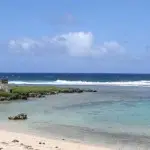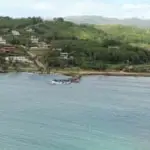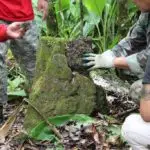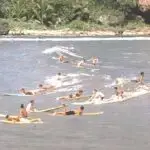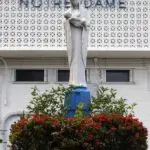Talo'fo'fo (Talofofo)
Table of Contents
Share This
Origin of village name in CHamoru
The village probably derives its name from the phrase “entalo’ i fe’fo’,” which means between the cliffs. It’s possible that the name is derived from another word, fo’fo’, which means a bubbling spring. As the Talo’fo’fo River and the Talo’fo’fo Falls are located in the village, the name could mean “between the bubbling springs.”
Population
As of the 2010 US Census, the population was 3,050.
Village officials
The current mayor of Talof’ofo’, Vicente S. Taitague, was first elected in 2008.
Village description
Former Mayor Tito Mantanona coined the name “God’s Country” for Talo’fo’fo, a nickname affectionately used by many residents and seen on signs throughout the village. At the heart of Talo’fo’fo is a four-way intersection recognized as the crossroads of this small village. Anyone giving directions to a location in this village inevitably starts with this intersection, which is also at the heart of economic activity in Talo’fo’fo, with three corner stores doing business near the four-way intersection. North from the intersection is the village’s Catholic church, San Miguel Church, as well as the mayor’s office and houses, most of them similar to homes in suburban communities.
East from the intersection is the Onward Talo’fo’fo Golf Course, after which the road intersects with Route 17, locally known as Cross Island Road.
West from the intersection are more houses and Talo’fo’fo Elementary School, a sports field, and the Talo’fo’fo gym.
South of the intersection is the Seventh-day Adventist Church and Notre Dame High School. As the road heads downhill toward the Talo’fo’fo sub-communities of Ipan and Talo’fo’fo Bay, it passes the ancient Talo’fo’fo Caves.
Sitting below the hills of the main village is the coastal community of Ipan, Talo’fo’fo. A number of secluded beaches and a scattering of houses, along with a gas station, make up most of Ipan. The area also includes Ipan Beach Park, a popular spot for barbecues. Jeff’s Pirates Cove is located on the northern border of Ipan and has become an institution in the area. It is best known for its relaxed-atmosphere bar and grill, along with a small souvenir store and an outdoor area used for arts and craft fairs, concerts and other gatherings.
The southern boundary of Talo’fo’fo is marked by the Ugum River (joined by the Talo’fo’fo River), which flows into Talo’fo’fo Bay. But as the Talo’fo’fo Bay park facilities are on the southern side of the bay, the area most people visit in Talo’fo’fo Bay is actually part of the neighboring village, Inalåhan.
Village history
The original pre-Spanish inhabitants of Talo’fo’fo lived mostly in settlements along the Talo’fo’fo and Ugum rivers, although artifacts have been found in the Talo’fo’fo Caves, perhaps suggesting that people used the caves for shelter during typhoons.
In 1672, Spanish Jesuit priest Father Diego Luis de San Vitores ordered a church to be constructed at the Pigpug settlement near Talo’fo’fo Bay, and this church became the center of the new Christian community.
The settlement never grew very large in size or prominence, although Talo’fo’fo Bay was the site of a few notable landings. One such landing was in 1788 of a large group of islanders from Lamotrek in the Caroline Islands, who arrived in canoes on a trading mission to obtain iron. It was the first such expedition since inter-island trade had come to a halt due to the Spanish-CHamoru Wars 100 years before. The Spanish-CHamoru Wars were a series of rebellions by some of the CHamorus against Catholic indoctrination many years before.
After several months, the Carolinians departed for Lamotrek with iron and trade goods, but it later turned out that they never reached home and were probably hit by a storm. Don Luis de Torres, a Spanish-CHamoru military officer, travelled to Woleai in 1804 to reassure the Carolines that their peers had not died at the hands of the Spanish. Carolinians subsequently resumed their annual trading voyages to Guam.
Talo’fo’fo Bay was also the site of the eastern landing of Japanese forces during the invasion of Guam on 10 December 1941, when a detachment meant to land at Ylig Bay in Yona mistakenly landed at Talo’fo’fo Bay instead. The detachment marched north to Hagåtña to meet the other landing forces.
In April and May of 1944, the American forces first started preparing for the invasion of the Marianas, including bombing raids over Guam and Saipan. On April 8, the submarine USS Seahorse torpedoed the 6,780-ton Japanese converted submarine tender Aratama Maru near the eastern coast of Guam, and the burning ship made it into Talo’fo’fo Bay, sinking three days later.
From August 1944 to September 1945, after the Americans recaptured Guam from the Japanese, the military government built the new community of Talo’fo’fo in the hills where it now stands.
In the northern part of Ipan, a Flight Personnel Rehabilitation Camp was built in 1945, with a beer garden, softball diamonds, volleyball courts, and horseshoe pitching pits. Later, a salt-water swimming pool was built. After providing for nearly 10,000 officers and soldiers, the camp was devastated in 1949 by Typhoon Allen.
In 1951, the San Miguel Church was constructed in the main village. While Talo’fo’fo had previously been a part of the municipality of Inalåhan under the municipalities established in 1920 by the pre-war U.S. government, Talo’fo’fo soon became a municipality of its own after the war.
In 1972, two hunters from Talo’fo’fo, Jesus M. Duenas and Manuel Degracia, discovered and captured a Japanese soldier named Sgt. Shoichi Yokoi who had been living in the jungles of Guam for 28 years. Yokoi’s incredible story quickly spread around the world. Instead of allowing himself to be captured by American forces in 1944, Yokoi and 10 others hid in the hills of Talo’fo’fo.
Yokoi was the only survivor, making clothing from the fibers of wild hibiscus plants and surviving on a diet of coconuts, breadfruit, papayas, snails, eels, and rats. He lived in a tunnel-like underground cave in a bamboo grove not far from Talo’fo’fo Falls. After he was discovered, Yokoi became a celebrity, after nearly three decades of seclusion. He died in 1997 at the age of 82.
Points of interest
Village map
Institutions
Notre Dame High School
Nestled in the hillside of Talo’fo’fo village, Notre Dame High School established on Guam in 1968 by the School Sisters of Notre Dame, is one of three Catholic high schools on Guam, but the only co-educational facility.
Talo’fo’fo Elementary School
Constructed in 1965, Talo’fo’fo Elementary School, remains the only public school servicing the elementary-aged children of this close-knit southern village.
Historical
Talo’fo’fo Caves
This series of caves on the side of the cliffs of the main village of Talo’fo’fo are famous for artifacts and pictographs of the ancient CHamorus.
Recreational
First Beach
Island residents and visitors frequent this area that has about three large coral holes forming submerged natural pools in the waters of a beach located in Ipan just before the entrance to the main Talo’fo’fo village.
Ipan Beach Park
This shaded beach area features several pavilions and barbecue pits, along with trees that keep beachgoers cool even on hot days.
Tongan Beach
Located along Route 4, just past Ipan Beach Park, this privately owned resort offers residents a camping experience. The small resort includes a large pool and restrooms with changing areas. Several local companies and organizations have reserved the space for private parties on the beach.
Jeff’s Pirates Cove
Now a landmark on Guam, this popular establishment features a bar and grill with local food, a gift shop, a small museum, and recreational grounds that has been owned by Jeff Pleadwell since 1979. Numerous concerts have been held there, along with a semi-annual arts and crafts fair, weddings, and other parties. A previous owner was said to have found evidence of Malay pirates having stayed in the area, inspiring the Cove’s name, but in 1962 Typhoon Karen wiped out all traces of the Malay village, including a pirate ship scuba divers discovered in 1953.
Valley of the Latte
Formerly known as the Jungle Riverboat Cruise, scenic boat tours of Talo’fo’fo and Ugum Rivers go to the ancient Talo’fo’fo Village, the site of a CHamoru hut and latte stones. Visitors can enjoy CHamoru cultural activities, demonstrations, local food, and a petting zoo.
Onward Talo’fo’fo Golf Club
Designed by nine American professional golfers, this course offers spectacular views. It features a relatively flat front nine, with fairways lined by tropical trees, flowers, and water hazards. Hole 6 is designed as a replica of Talo’fo’fo Falls and is good for scenic photo opportunities. The back nine is more difficult but overlooks Guam’s tropical jungle and mountains.
Talo’fo’fo Falls
Located along the Ugum River, on the boundary between Talo’fo’fo and Inalåhan, the Talo’fo’fo Falls are accessed by a road in Malojloj, Inalåhan. At the bottom of the two-tier falls are swimming holes popular among visitors. The falls have been turned into a tourist destination, with a paved road, visitor facilities, and an entrance fee. A replica of Sgt. Yokoi’s cave is nearby, as the original cave collapsed.
Village mayors/commissioners
Before World War II, the commissioners of Talo’fo’fo were appointed by the Naval governor. Starting in 1952, the commissioners and mayors were elected.
- Vicente S. Taitague, Mayor, 2009-Present
- Pedro D. Paulino, Mayor, 2005-2009
- Anthony C. Leon Guerrero, Mayor, 2001-2005
- Vicente S. Taitague, Mayor, 1997-2001
- Tito A. Mantanona, Commissioner/Mayor, 1981-1997
- Roman LG Quinata, Commissioner, 1969-1981
- Juan C. Tenorio, Commissioner, 1961-1969
- Jose P. Cruz, Commissioner, 1952-1961
- Vicente Cepeda, Castro Commissioner, 1941-1944
- Cayetano Aguon Quinata, Acting Commissioner, 1928-1929
- Vicente Cepeda Castro, Commissioner, 1920-1928
Deputy commissioners
- Jose Castro Aguon Deputy Commissioner/Acting Commissioner, 1939-1941
- Vicente Cepeda Castro Deputy Commissioner, 1917-1920
Editor’s note: The preceding list was provided by Konsehelon Mahot Guåhan/the Mayor’s Council of Guam.
For further reading
Mayors Council of Guam. “MCOG – Mayors Council of Guam.”
Onedera, Peter R., ed. Nå’an Lugåt Siha gi ya Guåhan (Guam Place Names). Hagåtña: Chamorro Language Commission, 1988.

